About The Research
The research focuses on the current status of equal opportunity development in the workplace and asks respondents a series of questions about equal opportunity in the hiring process and workplace life, aiming to help companies make better diversity, equality and inclusion decisions and promote equal opportunity in the workplace.
A total of 1,527 employees from mainland China participated in the survey, from the Retail (15%), Internet (11%), FMCG (11%), High-Tech (9%), Pharmaceutical and Life Sciences (9%), Manufacturing (7%), Legal (6%), Real Estate and Construction (6%), and Banking and Finance (6%) industries.
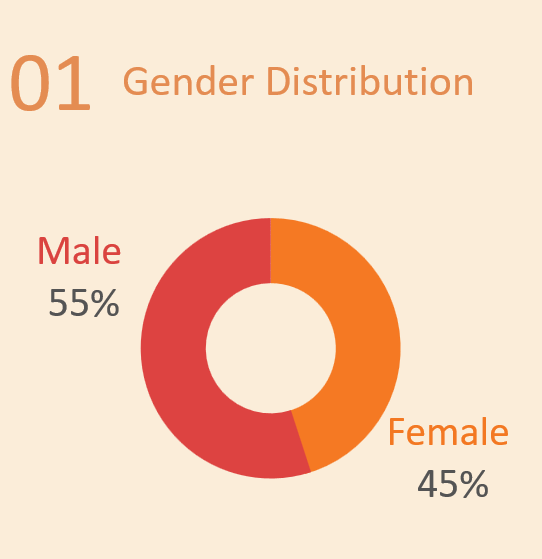
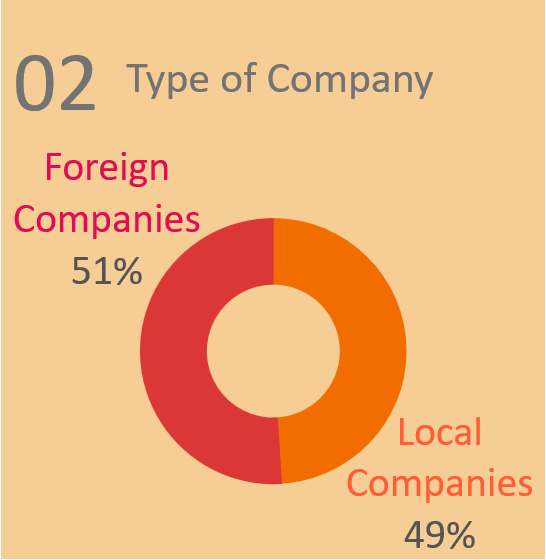

Equal Opportunities In Recruitment
OFF-TOPIC CONVERSATION DURING THE INTERVIEW
Nearly 77% of the survey respondents said that they had been asked about their relationship status, marriage, physical health and other such topics not directly related to the work in the job interview process.
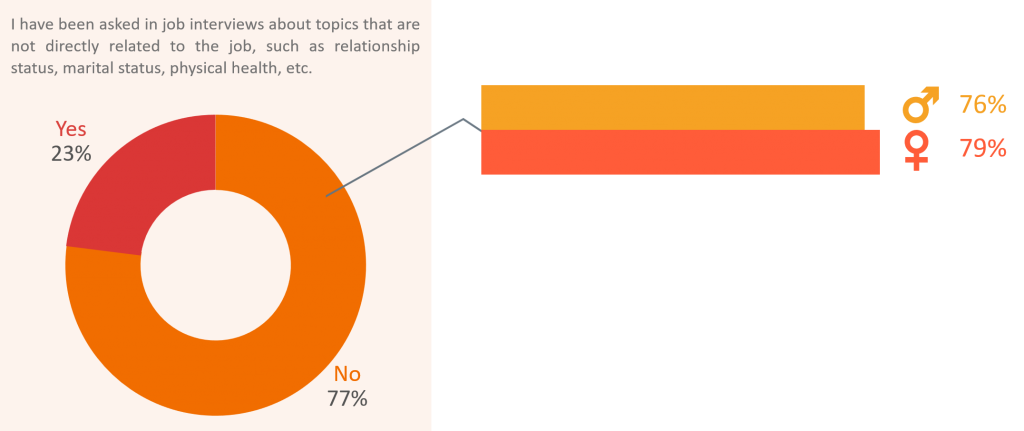
The survey results show that gender is not a major reason for recruiters to ask relevant questions, and that men and women are similarly likely to be asked non-job related questions in interviews.
While these situations are common in the hiring process, such “off-topic” conversations are not directly relevant to an organisation’s understanding of a candidate’s ability to perform the job, and may affect the fairness of the hiring process.
When respondents were asked about topics not directly related to their job because of their gender during the interview, 64.5% of male respondents chose to answer. However, nearly three-quarters of female respondents would feel uncomfortable in the same situation, and about one-third of them would raise concerns and reconsider whether to answer. Women are more sensitive to gender-related issues raised by companies during job interviews, more aware of possible gender bias, and more insecure.

GENDER IS STILL A BARRIER IN JOB HUNTING
59% of the 840 male respondents indicated that they had been unable to secure their ideal position due to gender restrictions on hiring; at the same time, 63% of women experienced similar challenges.
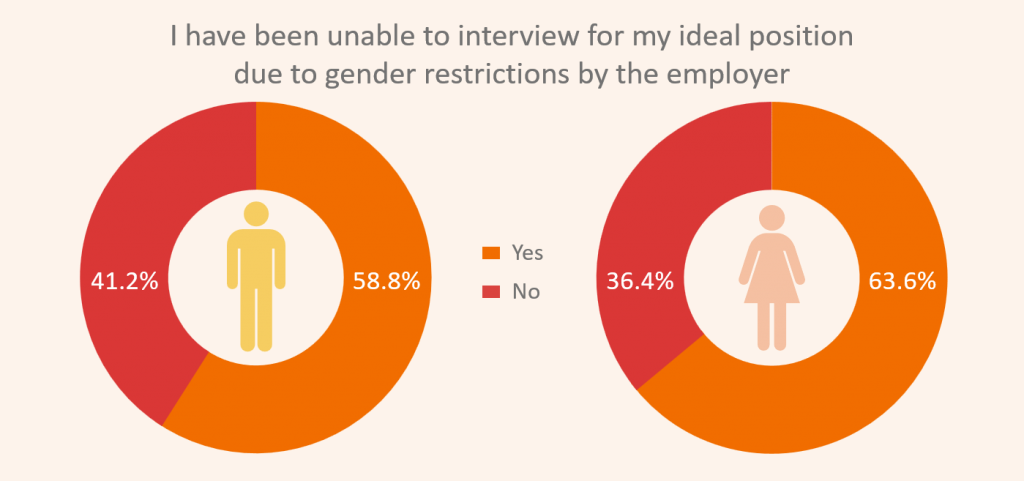
Both men and women suffer more than half of the gender restrictions in the job search process, which shows that the gender factor is still one of the obstacles to the development of equal opportunities in the workplace.
Different industries have certain differences in gender requirements and preferences for job seekers
81% respondents from High-tech industries all reported that they had lost interviews due to industry gender preferences. 79% respondents from the Manufacturing industry said they had limited their career choices because of their gender, and also suffered from more severe gender bias. On the other hand, industries such as Education and Training, Banking and Finance, Catering, and Professional Services tend to have lower gender-based thresholds, which makes them more inclusive.
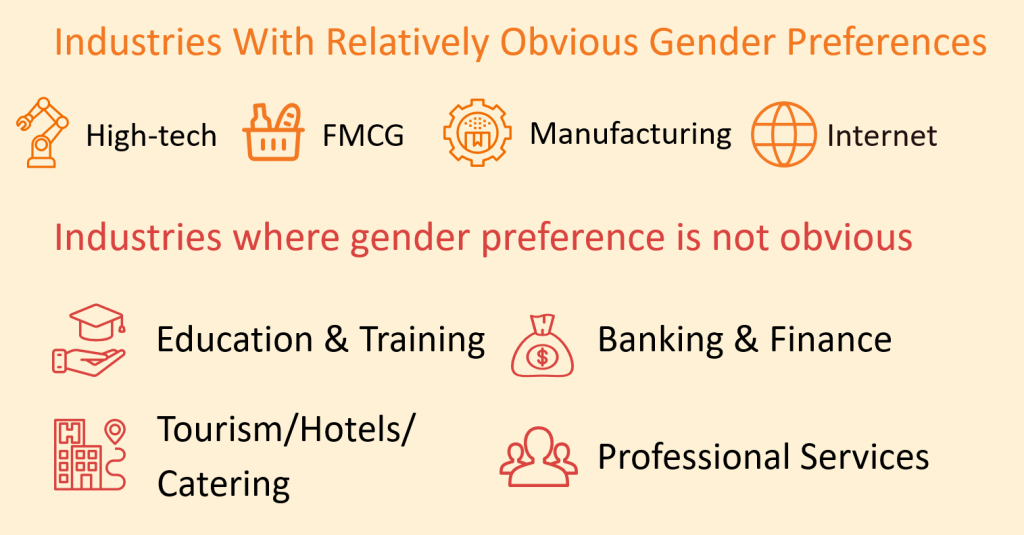
THE IMPACT OF FEMALE LEADERSHIP ON RECRUITMENT
Nearly half of the job seekers believe that having a large percentage of female leaders is a plus for companies when hiring.
Candidates expect to see companies practicing a culture of diversity and equality, and the number of female leaders in management is one of the manifestations that will be of interest to candidates.
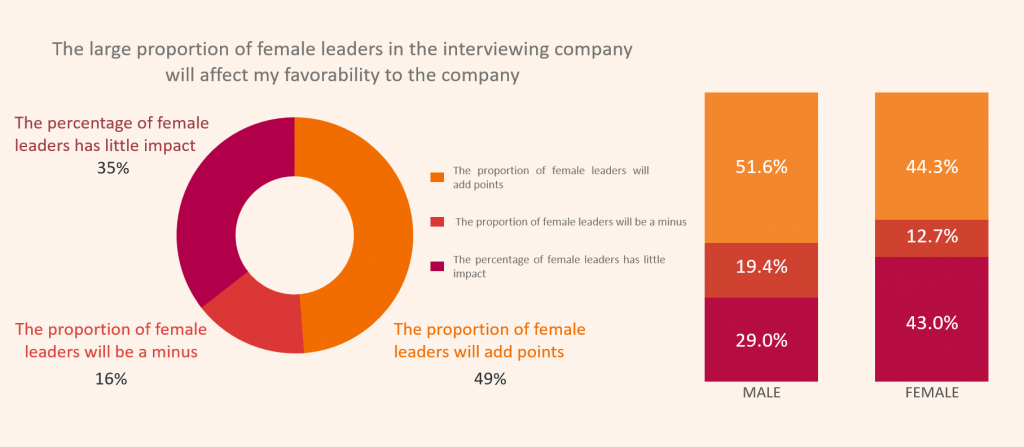
Male job seekers are more concerned about the percentage of female leaders in the companies where they are seeking employment. About 71% of male respondents would care about the number of female leaders in their companies, with 51.6% of them believing that a large percentage of female leaders is a plus for their companies and 19.4% holding the opposite opinion.
Based on the overall performance of respondents, respondents from the Retail, Professional Services, Internet, and Banking & Finance industries generally believe (>50%) that companies with a greater percentage of female leaders in the job search process will be more desirable.
However, the FMCG, High-tech and Pharmaceutical industries have more concerns about the high percentage of female leaders. In the FMCG industry, 44.4% of respondents believe that a high percentage of women in management weakens the attractiveness of recruiting companies, surpassing the percentage of respondents in the same industry who believe that female leadership is a plus in corporate recruitment (33.3%).
RECRUITMENT STANDARDS
Male interviewers are more mindful of the candidate’s gender when hiring.

GenZ is a sensitive and conscious generation that is more focused on equal opportunity.
When interviewers ask questions about topics not directly related to the job because of gender, more than a third of the young people are brave enough to raise concerns, saying that a person should be evaluated on the basis of ability, experience and leadership qualities, not gender.
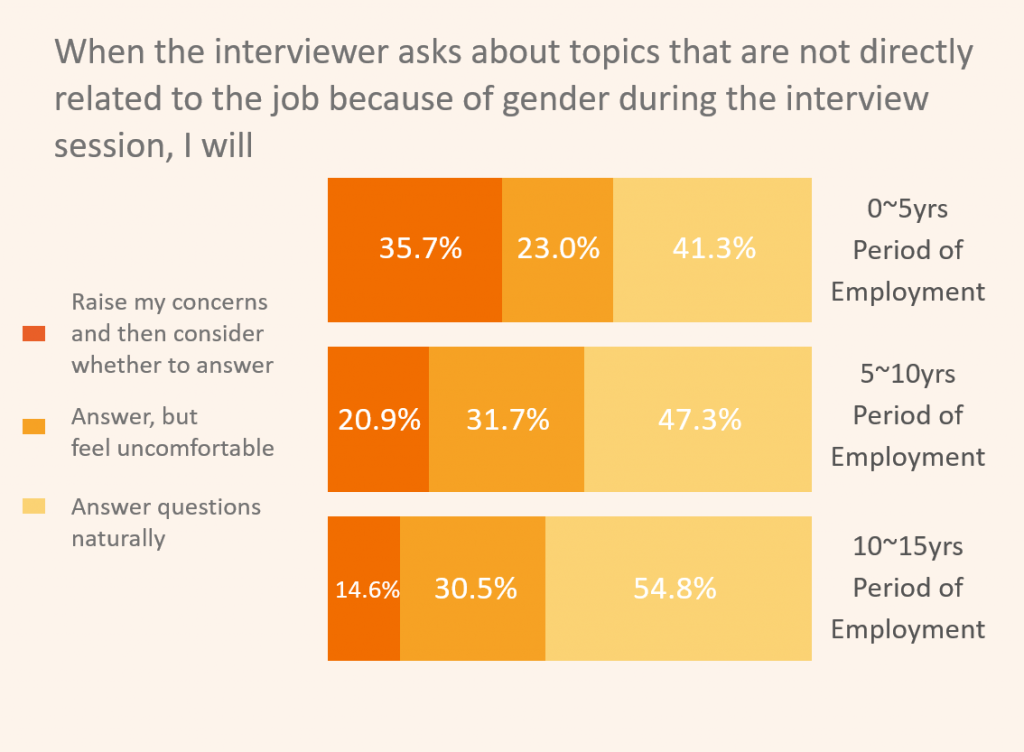
GENZ CARE MORE ABOUT CORPORATE EQUALITY & DIVERSITY
GenZ is a sensitive and conscious generation that is more focused on equal opportunity.
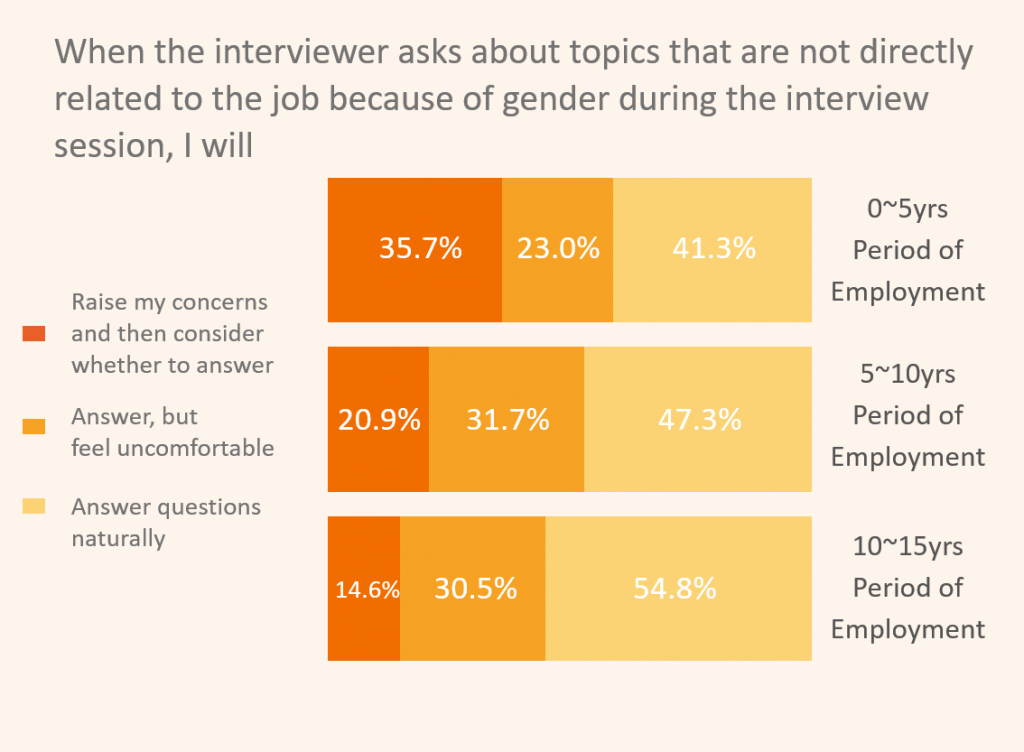
Efforts that a company makes in terms of equal opportunities will become a consideration for young candidates when they make their choice.

HOW TO REFLECT THE CULTURE OF EQUAL OPPORTUNITY IN RECRUITMENT
- Using Inclusive Language
The language companies use in hiring may attract certain types of candidates and exclude others. Data suggests that the mere use of the word “competitive” is more likely to deter women from applying for a job, and gender-biased hiring language may also lead to a reduction in women’s voice in STEM fields.
- Standardising The Interview Process
Different interviewers, with different personal preferences and concerns, can lead to different criteria for hiring candidates. Using the same professional yardstick to measure candidates allows interviewers and HR to screen candidates on a consistent basis, guided by competency rather than personal preference. Ensure that each candidate has an equal opportunity to demonstrate their skills and experience during the hiring process. Finally, it is also possible to understand candidates’ feelings and feedback on the hiring process by conducting regular return surveys on the process and improving the process based on the feedback.
- Integrating Equal Opportunity into the Company’s Growth Strategy and Talent Planning
In research related to the Top 10 Most Female-Focused Employers of the Year 2021 in China, the percentage of female employees in a company is an important indicator of gender equality. Among the top 10 companies on the list, the average percentage of female employees is 55.4%, and the percentage of mid-level women and the percentage of promoted women are slightly ahead of companies not on the list.
In addition to earning a higher GEI index score for the company, a high proportion of female employees, a more balanced gender ratio at the top, and more equal promotion paths will greatly promote the formation of a fair workplace environment and lay the foundation for the long-term development of the company.
Excellent Corporate Practice
L’Oréal Group is always striving to tap into the power of women and empower them. According to internal data, the percentage of women in L’Oréal’s management has exceeded 50%. Externally, L’Oréal China has been supporting the first “She Forum”, the world’s leading forum for scientists, and has been promoting a better development environment for female scientists. L’Oréal China also created the “Beauty Business, Better Life” program to focus on disadvantaged women and support them to achieve a better life through public service training.
Equal Opportunities In Recruitment
GENDER DISCRIMINATION PHENOMENON
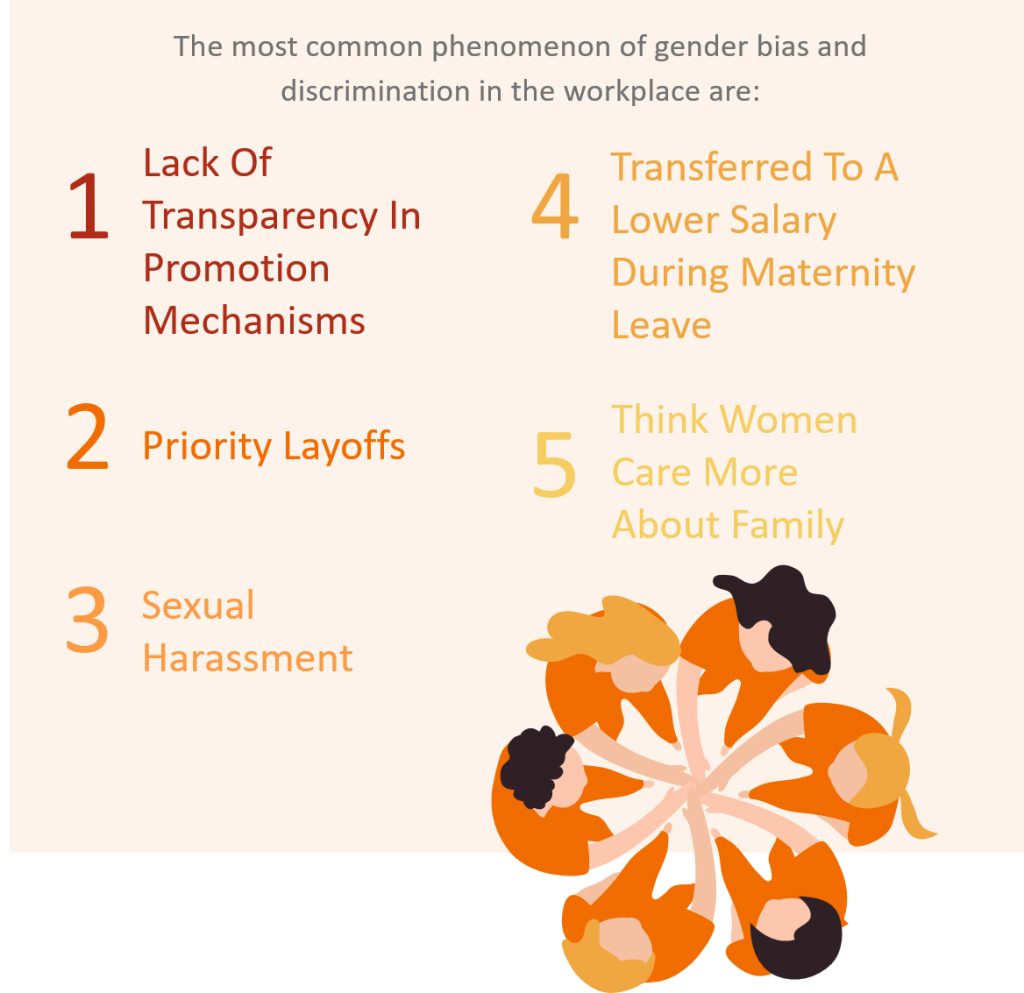
Newcomers in the workplace don’t know how to protect themselves in the face of gender bias.

HOW TO HELP EMPLOYEES COPE WITH GENDER INEQUALITY IN THE WORKPLACE
Establish Clear And Transparent Promotion Criteria
Provide regular performance feedback to employees to promote and ensure that all qualified candidates have the potential to be promoted. Use objective, KPI-based criteria to determine which employees are selected for layoff, rather than relying on subjective judgment or personal bias.
Develop And Implement Policies That Address Sexist Behavior
Prohibit sexual harassment and clearly outline the consequences of engaging in such behavior. Conduct relevant training to help employees recognize and respond to harassment and create a culture that encourages whistleblowing and takes all complaints seriously.
Provide A Convenient Work Environment For Female Employees
Installing women-friendly facilities in the workplace and implementing telecommuting or hybrid office models can help women gain new economic opportunities and a greater sense of well-being in their work lives, and can increase employee motivation, belonging and loyalty.
Excellent Corporate Practice
YumChina, the largest restaurant company in China, has been listed in the GEI Bloomberg Gender Equality Index for five consecutive years, the most frequently listed company in mainland China. KFC, a well-known fast food chain under Yum Group, has launched the “Little Migratory Bird Moms Restaurant” public welfare model, which provides employment opportunities for parents who are willing to return to their children after working outside for a long period of time, with comprehensive welfare protection and flexible scheduling, allowing parents to keep company and work at the same time. The company has opened more than 760 restaurants in Hubei, Henan, Chongqing, Hunan, Anhui and other provinces.
PayPal China has been certified as the best workplace for women in Greater China in 2021 and 2022, and has created a convenient work environment for female employees, such as a mother and baby room, feminine products, and pregnancy workshops. In addition, they also invited employees from the technology department to conduct programming classes for children to solve the worries of “mom” employees at work.
WELFARE MEASURES
Foreign companies have more awareness and measures to provide benefits to female employees than local companies
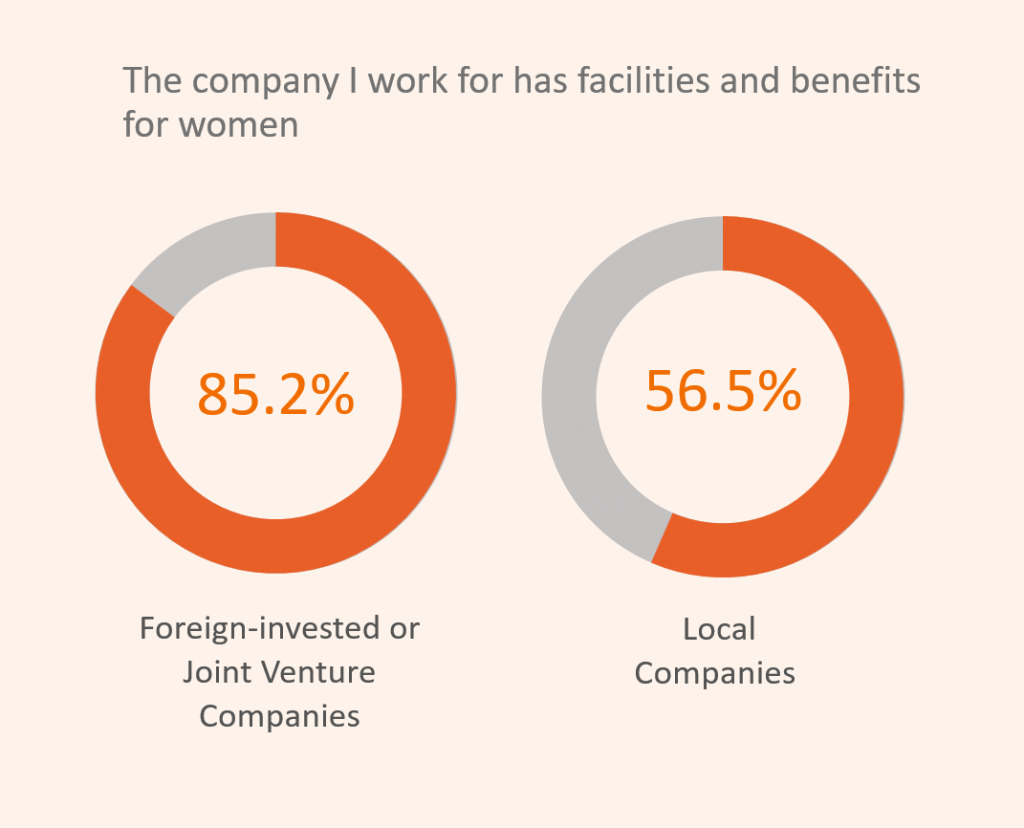
Excellent Corporate Practice
Johnson & Johnson is committed to gender equality and has taken a number of steps to improve the status of women in the company. For example, the company has established the Johnson & Johnson Family Care Program, which provides employees with parental leave, family medical leave and flexible work schedules. In addition, the company conducts regular training courses and workshops to help women employees improve their professional skills and leadership.
HOW CAN COMPANIES PROMOTE GENDER EQUALITY
What measures can companies take to create a more gender-equal work environment:
- Identify outstanding female leaders, promote gender equality in management, and focus on the percentage of female executives
- Provide a mechanism to deal with discrimination, handle complaints promptly, and punish discrimination and bias
- Improve the system related to recruitment, promotion, job treatment, etc.
- Provide benefits for female workers, such as flexible working hours and workplaces for pregnant and breastfeeding women
GENDER EQUALITY AWARENESS
Gender bias exists differently in different scenarios
The majority of respondents believe that the phenomenon of gender bias is felt more in the workplace than in their daily lives.
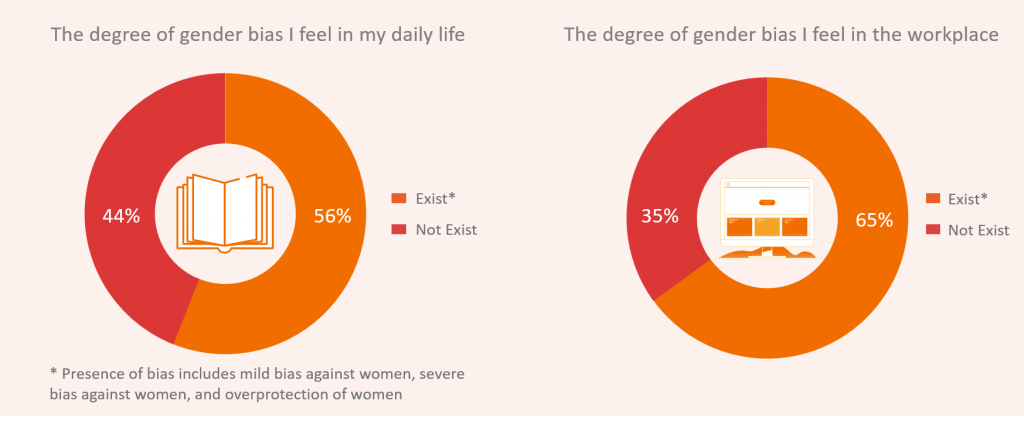
CREATING A GENDER-EQUAL CORPORATE CULTURE
Gender bias in the workplace from different perspectives
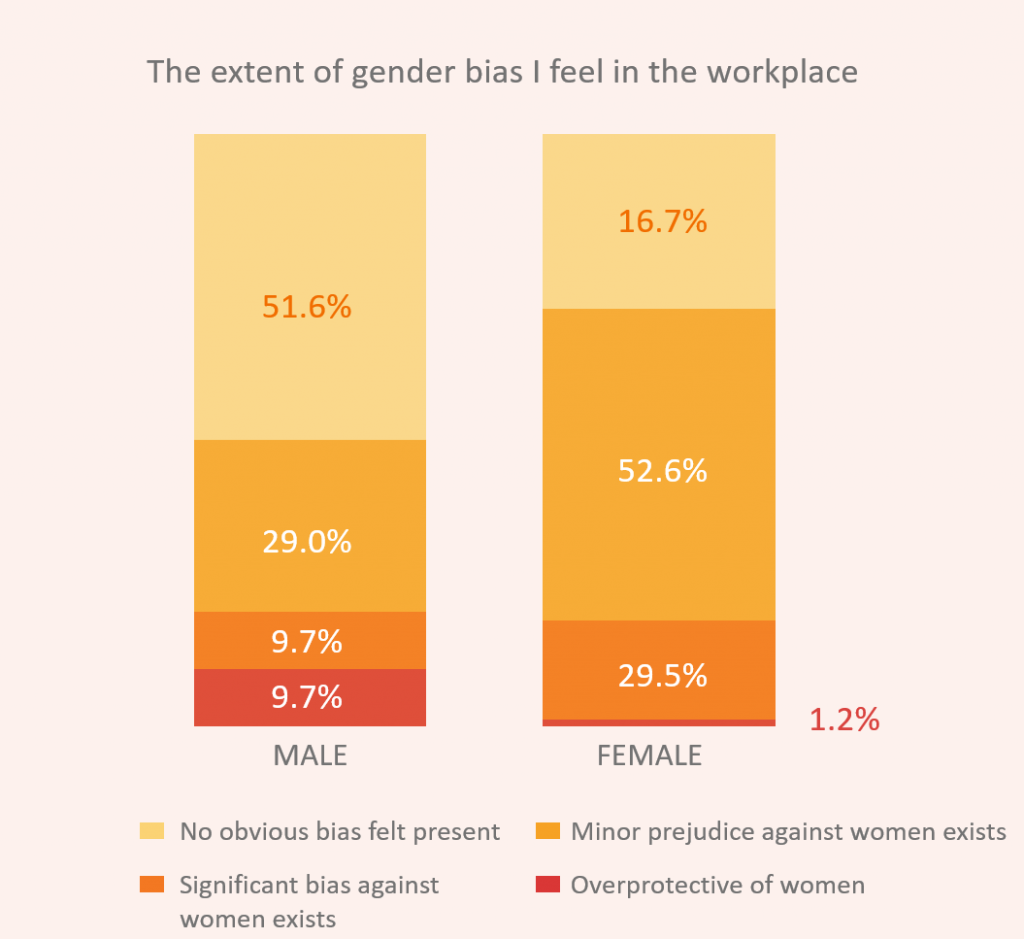
Excellent Corporate Practice
As a leading French luxury brand, Chanel has been committed to breaking down gender barriers in the industry. The company has a number of women executives in management and has established several programs to support women’s career development and advancement in the company. For example, Chanel’s “Women’s Innovation Fund” aims to support entrepreneurial women and improve the status of women in the business world.
P&G is proactive in creating an inclusive, gender-equal environment within the company and believes that equality in family functions will help promote equality in the workplace. Through the introduction of a global parental leave policy, all parents are eligible for at least eight weeks of paid leave, and mothers who give birth receive an additional six weeks of postpartum recovery leave. While promoting gender and intersectional equality in workplaces around the world so that everyone can reach their full potential.

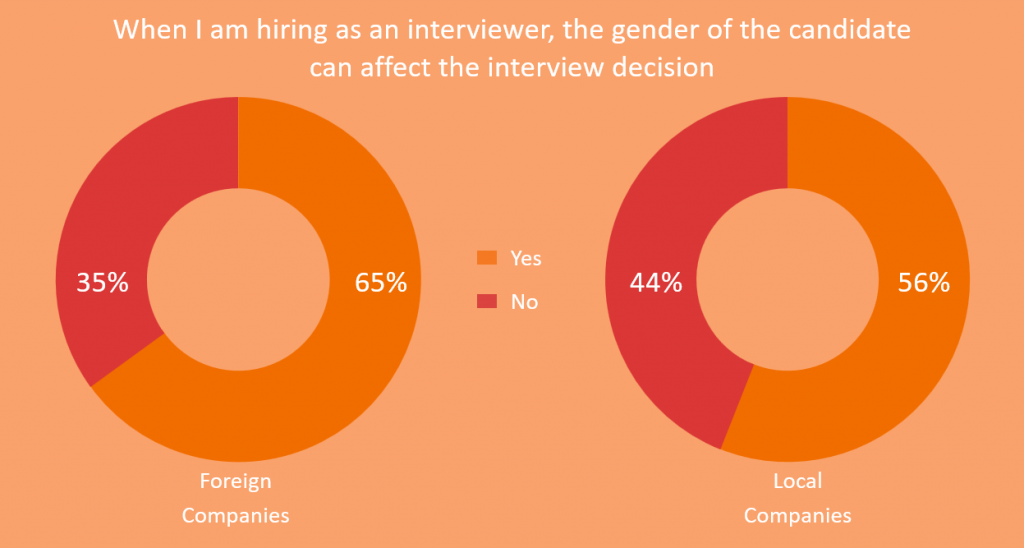
GENZ CARE MORE ABOUT CORPORATE EQUALITY & DIVERSITY
GenZ is a sensitive and conscious generation that is more focused on equal opportunity.
When interviewers ask questions about topics not directly related to the job because of gender, more than a third of the young people are brave enough to raise concerns, saying that a person should be evaluated on the basis of ability, experience and leadership qualities, not gender.

GENZ CARE MORE ABOUT CORPORATE EQUALITY & DIVERSITY
GenZ is a sensitive and conscious generation that is more focused on equal opportunity.

Efforts that a company makes in terms of equal opportunities will become a consideration for young candidates when they make their choice.

HOW TO REFLECT THE CULTURE OF EQUAL OPPORTUNITY IN RECRUITMENT
- Using Inclusive Language
The language companies use in hiring may attract certain types of candidates and exclude others. Data suggests that the mere use of the word “competitive” is more likely to deter women from applying for a job, and gender-biased hiring language may also lead to a reduction in women’s voice in STEM fields.
- Standardising The Interview Process
Different interviewers, with different personal preferences and concerns, can lead to different criteria for hiring candidates. Using the same professional yardstick to measure candidates allows interviewers and HR to screen candidates on a consistent basis, guided by competency rather than personal preference. Ensure that each candidate has an equal opportunity to demonstrate their skills and experience during the hiring process. Finally, it is also possible to understand candidates’ feelings and feedback on the hiring process by conducting regular return surveys on the process and improving the process based on the feedback.
- Integrating Equal Opportunity into the Company’s Growth Strategy and Talent Planning
In research related to the Top 10 Most Female-Focused Employers of the Year 2021 in China, the percentage of female employees in a company is an important indicator of gender equality. Among the top 10 companies on the list, the average percentage of female employees is 55.4%, and the percentage of mid-level women and the percentage of promoted women are slightly ahead of companies not on the list.
In addition to earning a higher GEI index score for the company, a high proportion of female employees, a more balanced gender ratio at the top, and more equal promotion paths will greatly promote the formation of a fair workplace environment and lay the foundation for the long-term development of the company.
Excellent Corporate Practice
L’Oréal Group is always striving to tap into the power of women and empower them. According to internal data, the percentage of women in L’Oréal’s management has exceeded 50%. Externally, L’Oréal China has been supporting the first “She Forum”, the world’s leading forum for scientists, and has been promoting a better development environment for female scientists. L’Oréal China also created the “Beauty Business, Better Life” program to focus on disadvantaged women and support them to achieve a better life through public service training.
Equal Opportunities In Recruitment
GENDER DISCRIMINATION PHENOMENON

Newcomers in the workplace don’t know how to protect themselves in the face of gender bias.

HOW TO HELP EMPLOYEES COPE WITH GENDER INEQUALITY IN THE WORKPLACE
Establish Clear And Transparent Promotion Criteria
Provide regular performance feedback to employees to promote and ensure that all qualified candidates have the potential to be promoted. Use objective, KPI-based criteria to determine which employees are selected for layoff, rather than relying on subjective judgment or personal bias.
Develop And Implement Policies That Address Sexist Behavior
Prohibit sexual harassment and clearly outline the consequences of engaging in such behavior. Conduct relevant training to help employees recognize and respond to harassment and create a culture that encourages whistleblowing and takes all complaints seriously.
Provide A Convenient Work Environment For Female Employees
Installing women-friendly facilities in the workplace and implementing telecommuting or hybrid office models can help women gain new economic opportunities and a greater sense of well-being in their work lives, and can increase employee motivation, belonging and loyalty.
Excellent Corporate Practice
YumChina, the largest restaurant company in China, has been listed in the GEI Bloomberg Gender Equality Index for five consecutive years, the most frequently listed company in mainland China. KFC, a well-known fast food chain under Yum Group, has launched the “Little Migratory Bird Moms Restaurant” public welfare model, which provides employment opportunities for parents who are willing to return to their children after working outside for a long period of time, with comprehensive welfare protection and flexible scheduling, allowing parents to keep company and work at the same time. The company has opened more than 760 restaurants in Hubei, Henan, Chongqing, Hunan, Anhui and other provinces.
PayPal China has been certified as the best workplace for women in Greater China in 2021 and 2022, and has created a convenient work environment for female employees, such as a mother and baby room, feminine products, and pregnancy workshops. In addition, they also invited employees from the technology department to conduct programming classes for children to solve the worries of “mom” employees at work.
WELFARE MEASURES
Foreign companies have more awareness and measures to provide benefits to female employees than local companies

Excellent Corporate Practice
Johnson & Johnson is committed to gender equality and has taken a number of steps to improve the status of women in the company. For example, the company has established the Johnson & Johnson Family Care Program, which provides employees with parental leave, family medical leave and flexible work schedules. In addition, the company conducts regular training courses and workshops to help women employees improve their professional skills and leadership.
HOW CAN COMPANIES PROMOTE GENDER EQUALITY
What measures can companies take to create a more gender-equal work environment:
- Identify outstanding female leaders, promote gender equality in management, and focus on the percentage of female executives
- Provide a mechanism to deal with discrimination, handle complaints promptly, and punish discrimination and bias
- Improve the system related to recruitment, promotion, job treatment, etc.
- Provide benefits for female workers, such as flexible working hours and workplaces for pregnant and breastfeeding women
GENDER EQUALITY AWARENESS
Gender bias exists differently in different scenarios
The majority of respondents believe that the phenomenon of gender bias is felt more in the workplace than in their daily lives.

CREATING A GENDER-EQUAL CORPORATE CULTURE
Gender bias in the workplace from different perspectives

Excellent Corporate Practice
As a leading French luxury brand, Chanel has been committed to breaking down gender barriers in the industry. The company has a number of women executives in management and has established several programs to support women’s career development and advancement in the company. For example, Chanel’s “Women’s Innovation Fund” aims to support entrepreneurial women and improve the status of women in the business world.
P&G is proactive in creating an inclusive, gender-equal environment within the company and believes that equality in family functions will help promote equality in the workplace. Through the introduction of a global parental leave policy, all parents are eligible for at least eight weeks of paid leave, and mothers who give birth receive an additional six weeks of postpartum recovery leave. While promoting gender and intersectional equality in workplaces around the world so that everyone can reach their full potential.


